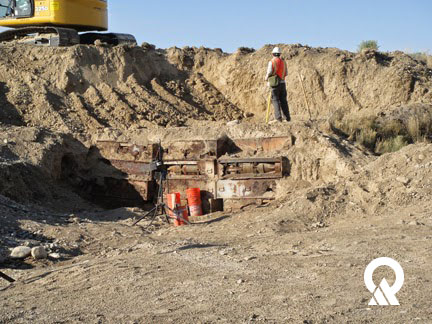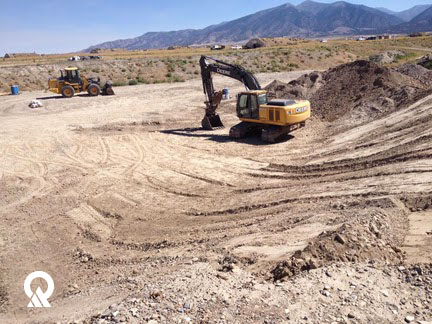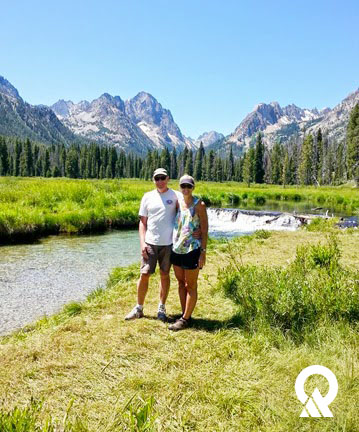By Dave Larsen
Can you think of a nice name for huge piles of waste from the demilitarization and testing of chemical agent bombs, projectiles, and other munitions? The U.S. Army likes to call this “legacy waste,” and it includes thousands of munitions that were disposed of on the ground or buried at Army facilities in Utah, including the Tooele Army Depot-South (TEAD-S).

TEAD-S is located about 30 miles southwest of Salt Lake City in the Rush Valley near Stockton, Utah. From the early 1940s to the 1980s, TEAD-S’s mission was to maintain and store chemical munitions in igloos (earthen and concrete bunkers) and other areas at the facility. The early mission also included some crude demilitarization, like open burning and detonation, as well as burial of old chemical weapons. From the late 1980s to 2014, the primary mission of TEAD-S was destroying the 44 percent of the nation’s chemical munitions stockpile stored at the facility. A demilitarization test facility and full-scale chemical weapons demilitarization incinerator were constructed to accomplish this. In August 2014, the Army successfully completed destruction of all the chemical munitions that had been held in storage.
Along with the destruction of chemical weapons stockpile, TEAD-S was required to conduct investigations and clean up as much of their legacy waste as safety conditions allowed. Although the waste on the ground surface can be carefully removed, worker safety usually precludes excavation of buried chemical and conventional munitions. This means the buried munitions are aptly named – legacy waste.

The Division of Solid and Hazardous Waste (DSHW) has been working with the Army through its Corrective Action Program to remediate this legacy waste at TEAD-S. Corrective Actions (CA) ensure that facilities deal with these wastes properly to minimize harm to the public and the environment.
The project to clean up this buried waste began about three years ago, and we anticipate that the majority of the work will be completed in Spring 2015. Work has included the surface removal of thousands of demilitarized munitions, drums, and other wastes at TEAD-S. The project removal sites are known as solid waste management units (SWMUs). Two of the larger sites are SWMUs 1 and 25, which occupy an area of about 1,500 acres and contain over 100 disposal pits and widespread surface contamination.
One of more difficult parts of the project was removal of a pile of mortars. This pile included over 50,000 mustard mortars, most of which had been demilitarized more than 50 years ago. As the Army’s explosive ordnance and disposal (EOD) experts inspected each mortar, they discovered that some of the mortars still contained mustard. These mustard-filled munitions were placed in an igloo at TEAD-S for later destruction.

This project is one of the larger ones I’ve worked on in my 25-year career as a project manager/geologist at DEQ. The project team includes the US Army and their EOD experts, Army contractors, chemical agent monitoring and safety experts, and staff from DSHW. Our involvement includes review and approval of work plans and reports, weekly site visits, and soil and groundwater sampling. The team meets monthly to review project progress.
Want to learn more about Corrective Actions? Check out the EPA website for information about the program. Curious about some of the projects we are working on in Utah? The EPA maintains a list of sites in Utah and the progress made on Corrective Actions in the state. You can find a short history of chemical agents at the Depot on the U.S. Army Chemical Materials webpage.

During my career at DEQ I have seen the importance of our work in helping protect and maintain a sustainable environment and how a good project team helps meet this goal. I also appreciate the opportunities employment at DEQ has offered me. I have been on military helicopters hunting for SWMUs, visited the chemical weapons incinerator on the Johnston atoll in Pacific, threatened with jail time for trying to take a photo at an Army base, fired a 155 mm white phosphorus round from a cannon at Marine base at 29 Palms in California, held a newly poured brick of gold at a Barrick mine, and had many other great experiences with my friends and colleagues at DEQ. I have been married to my wife Pam for 28 years, and we have four kids ages 26, 24, 19 and 15. Pam is an attorney and Director of Legal Services for an insurance company. We enjoy skiing, hiking and doing volunteer work for the Ronald McDonald House.

